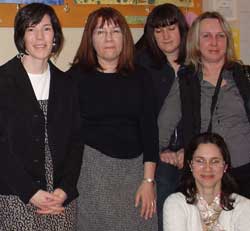Mission residents gain some private space of their own

Left to right: Laura Endacott (Studio Arts), Linda Szabad-Smyth (Art Education), Jennifer Wicks (student in Art Education), Janette Haggar (Art Education), Amie Neff (Grenier + Richards Architectes) is in front.
Marc Losier
Students and faculty members from Art Education and the Fibres stream of Studio Arts were on hand April 1 at the Old Brewery Mission Gallery to celebrate the vernissage of a unique pilot project.
This past year, the Mission’s Webster (for men) and Patricia Mackenzie (for women) Pavilions underwent major changes, thanks in part to a federal grant it received in 2005.
Under the leadership of local architect Amie Neff and the Mission’s director, James Hughes, the renovations created four new staff offices, larger living areas, laundry facilities and computer- resource rooms for house- and job-hunting. Hughes said the funding allows the shelter to maximize Étape, its 90-day rehabilitation and reintegration program.
“Ultimately, our niche is to know the homeless and help them plan their way out of shelter life permanently. It’s now a much more professional environment.”
Gone are the shelter’s numbered single beds; they’ve been replaced by staggered bunk beds that provide more privacy, with removable fabric screens.
Concordia’s involvement began in June 2006, when an informal discussion between Neff and Fibres professor Laura Endacott sparked the participation of four departmental classes this past winter term. The architect wanted each fabric screen to have a unique design, and asked Endacott for advice on which materials and dyes to use.
At a glance, replacing a shelter’s bed numbers with personalized fabric screens may not seem significant, but to the shelter’s clients, who are often victims of abuse, sleeping under a work of art that you can identify with rather than being tagged with a number might go a long way towards rediscovering your identity and sense of self.
Neff had also been in touch with local outreach groups in Montreal. When youth group Dans la Rue offered to contribute a large graffiti-style piece to the Mission, Neff was inspired to push the Concordia angle a little further.
She contacted Endacott to ask if she would be interested in having her students design the shelter’s new privacy screens, perhaps as part of their curriculum. Endacott accepted, and they were off.
“I think it’s an excellent opportunity for students, a real challenge, it bridges the academic world with the community” said the Fibres professor.
Endacott’s participation created excitement. The department expanded their contribution to include the Community Art Education courses of Linda Szabad-Smyth and part-time professors Janette Haggar and Carol Beer-Houpert.
Using the department’s network of safe houses and outreach centres in Montreal, Art Education students worked in small groups and completed their community service requirements — 20 hours each semester — by guiding community members in designing their own screens for the Mission.
The result has been one of the most dynamic outreach initiatives ever between a university and its city surroundings. “As far as I know, this is a pilot project of its own kind in North America,” Endacott said.
As for Neff, whose work on this project with Montreal firm Grenier + Richards will go towards completing her Canadian architectural license, she could not have been more pleased.
“The reaction so far has been that [the clients] feel a sense of pride, entitlement, which is really fabulous. They also feel separated from the emergency centre,” Neff said.
At the unveiling on April 1, artists from Montreal outreach centers St. James, Chez Doris, Manoir de L’Age d’Or, the Centre for Human Development Friendship Program, as well as children and adults from Concordia’s Saturday art school, all pitched in their own screens with help from Art Education students.
“It was art for a purpose, and I feel like it’s needed. I got a lot out of it,” said second-year Art Education student Jennifer Wicks.
Endacott hopes that the buzz created this year leads to continued involvement next year with other fine arts groups.